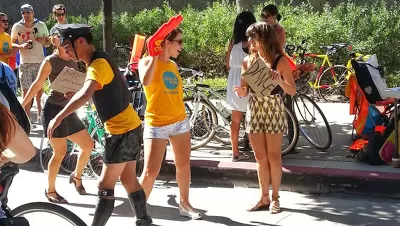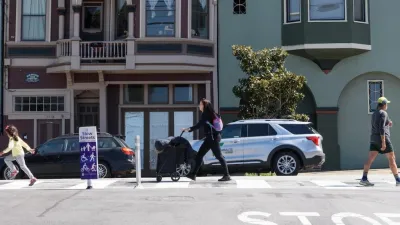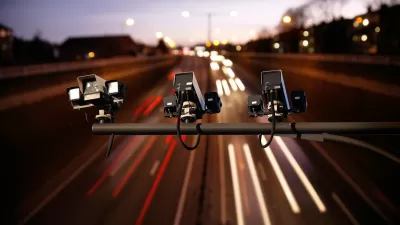Being on the street used to be a dance, but not so since the automobile took over. Is there a way for all modes to coexist through a mutual ethic rather than compete for a street’s right of way?

Get ready cities, here come the bike lanes! Although it’s the trendy topic these days, cycling has been a mode of urban transportation for well over a hundred years. To quote LL Cool J: “Don’t call it a comeback, I been here for years, rockin’ my peers and putting suckas in fear!”
After having been marginalized by the march of the automobile, bicyclists are starting to bob and weave their way back onto city streets. It isn’t much of a fight. Cyclist vs. driver might be hosted in the same ring but clearly they aren’t in a competing weight class.
Instead of equalizing the contenders, our current tactic is to cancel the main event and relegate users to their corridors of movement: sidewalks, bike lanes, driving lanes. It’s the perceived safe and reasonable thing to do. But now a new fight: the battle to get bike lanes onto streets. Sorry drivers—good-bye driving lanes and parking stalls! Slowly the city is wresting itself from the automobile’s grip. And to get people out of their cars it’ll take no less than appropriate, convenient and beautiful bicycle infrastructure. That should quell our tendency to believe the car is the right way of urban living. But sometimes our enabling infrastructure can have unintended consequences. Can a bike lane be detrimental to cyclists?
Being on the street used to be a dance. The first motorists had to sashay, moonwalk or perhaps twerk with the other dancers on the street. A motorist had to negotiate with other users; he had to pay attention to a pedestrian, a horse drawn carriage, a cyclist. But soon, as with our modern tendency to separate faculties for efficiency, the social and physical infrastructures were put in place to enable the automobile. In the musical chairs of using the street the car caught the last seat. The walker was literally cast aside, to the sidewalk. As the automobile continued to advance, so cities came to be designed for them—gas stations, wider streets, clover-leafs, suburbs, sound walls, garages, big box stores and on and on. And with this the incapacitation of other forms of transportation.

And now we’re left with our urban legacy: cities designed for the car. But we’ve been living in cities for thousands of years, and little is static in the manifestation of our desires, of all our mixed and muddled dreams and wishes. We’re becoming aware that perhaps the automobile isn’t the best way to orient the city. Maybe cities should be more people-scale oriented. And here’s the rub: instead of returning to the dance, we’re marching away.
For a quick cycling win we paint lines on a street, put up signage, and claim a success. “Here be bike lane!” And it is a success. But it’s also still a bike lane in an auto-oriented street—or even an auto-oriented neighbourhood. The lane might help a bit, it’s good for optics and awareness-raising, but in the winter it tends to be where the snow gets plowed, along with the accompanying gravel. During winter’s thaw, or rain showers, it’s where the cyclist goes to be sprayed by passing motorists. Sometimes they’re closed during non-commuting hours. But these design shortcomings have a deeper psychological shortcoming:
There’s no shared ethic, no negotiation; there’s no more dancing!
But who wants to dance with a car rushing by at 50, 60, 80 km/h?
Party crashers should be relegated to a wallflower, relegated to arterial roads. That’s where those speeds belong. But they can be invited onto the dance floor. They’ll just have to slow down a little. Instead of relegated to marching, let’s embrace dancing. Design streets for a shared ethic, for sharing space. It’s where the community is; it feels like a place; it’s where people dance, live,be.
And maybe, just maybe, a motorist will see this, will want to let go her car, ask her city administrators and councillors for dance-able streets. Yes, dance-able! Streets, as Lewis Mumford might have said, are for lovers. Communities, by definition, are places of sharing, so let’s share the road too, make it dance-able, not just for walkers and cyclists and drivers but for dancers. The transportation system is a complex one but there is indeed room in it for negotiating the use of its space. Bring on dance-ability!
To help get you onto the dance floor, here’s Daft Punk featuring Pharrell Williams to lift you up out of your seat!
I know you don't get a chance to take a break this often
I know your life is speeding and it isn't stopping
Here take my shirt and just go ahead and wipe up all the
Sweat, sweat, sweatLose yourself to dance
Lose yourself to dance
Lose yourself to dance
Lose yourself to danceLose yourself to dance
Lose yourself to dance
Lose yourself to dance
Lose yourself to dance
Connect with Steven on Twitter @stevenpsnell or Facebook stevenpsnell.
His novel, The Undergraduates, is available for download here, or at any fine ebook retailer.

Alabama: Trump Terminates Settlements for Black Communities Harmed By Raw Sewage
Trump deemed the landmark civil rights agreement “illegal DEI and environmental justice policy.”

Planetizen Federal Action Tracker
A weekly monitor of how Trump’s orders and actions are impacting planners and planning in America.

The 120 Year Old Tiny Home Villages That Sheltered San Francisco’s Earthquake Refugees
More than a century ago, San Francisco mobilized to house thousands of residents displaced by the 1906 earthquake. Could their strategy offer a model for the present?

In Both Crashes and Crime, Public Transportation is Far Safer than Driving
Contrary to popular assumptions, public transportation has far lower crash and crime rates than automobile travel. For safer communities, improve and encourage transit travel.

Report: Zoning Reforms Should Complement Nashville’s Ambitious Transit Plan
Without reform, restrictive zoning codes will limit the impact of the city’s planned transit expansion and could exclude some of the residents who depend on transit the most.

Judge Orders Release of Frozen IRA, IIJA Funding
The decision is a victory for environmental groups who charged that freezing funds for critical infrastructure and disaster response programs caused “real and irreparable harm” to communities.
Urban Design for Planners 1: Software Tools
This six-course series explores essential urban design concepts using open source software and equips planners with the tools they need to participate fully in the urban design process.
Planning for Universal Design
Learn the tools for implementing Universal Design in planning regulations.
Clanton & Associates, Inc.
Jessamine County Fiscal Court
Institute for Housing and Urban Development Studies (IHS)
City of Grandview
Harvard GSD Executive Education
Toledo-Lucas County Plan Commissions
Salt Lake City
NYU Wagner Graduate School of Public Service






























